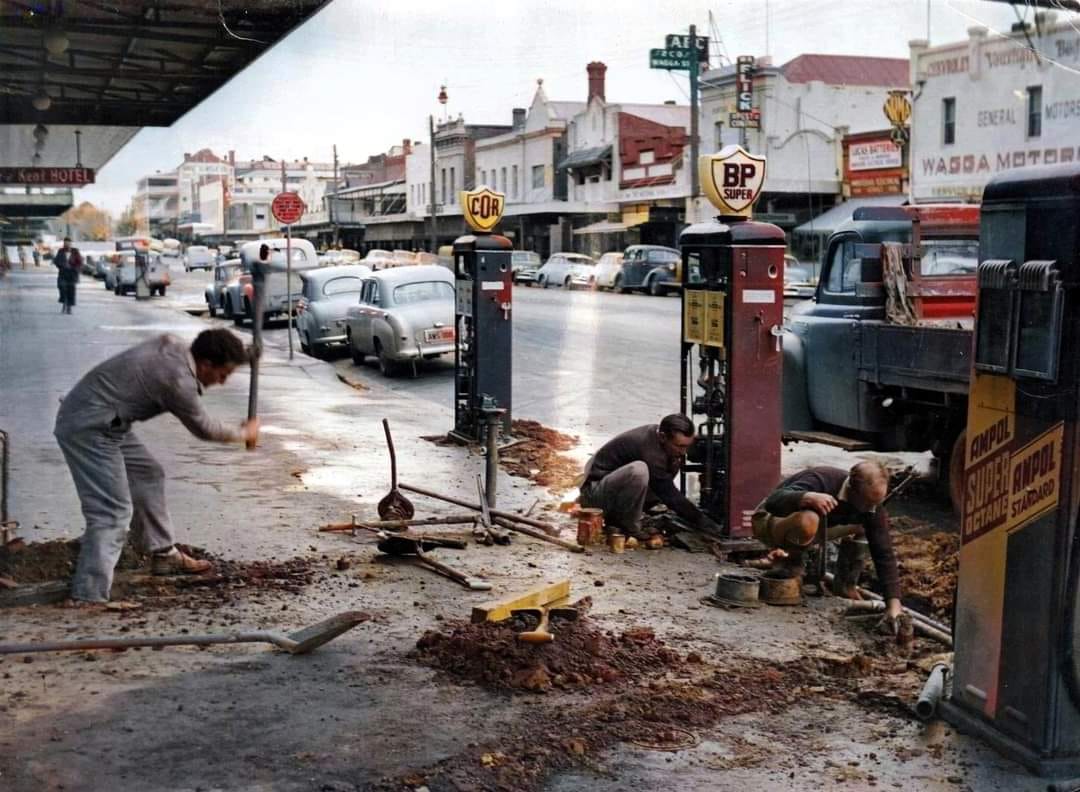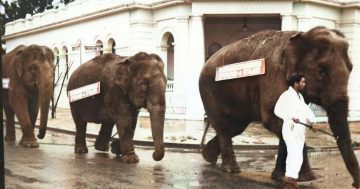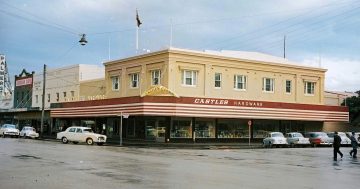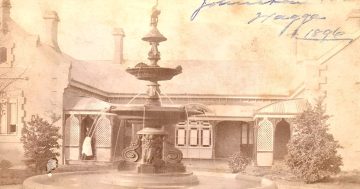
The removal of bowsers owned by the Douglas Body Company on Fitzmaurice Street, c. 1960s. Photo: Bob Douglas (coloured using Palette).
Do you remember the old petrol bowsers on the streets of Wagga?
In the opening years of the 20th century, few Australians owned cars. As a result, there weren’t many formed roads, and there were no garages. Petrol could only be purchased in four-gallon tins (about 18 litres) from some chemists, grocers or hardware stores.
In 1902, S F Bowser & Co marketed a domestic petrol bowser in America, and from the 1920s, in Australian towns and cities (including Wagga), several service stations and garages had opened, selling fuel from roadside pumps rather than the previously mentioned tins.
As Bowser was the first to manufacture domestic pumps, Australians came to know the fuel dispensers that sprang up around town as ”bowsers”. The bowser petrol pump system enabled motorists to fill their tanks with petrol in a few minutes, with a mere ”turning of the hose”.
Local businesses including the Douglas Body Company on Fitzmaurice Street, Great Southern Motors on the corner of Baylis and Morrow streets (now the Myer building) and even the Avor Cordial Factory (now the Sturt Mall car park) had their own bowsers out the front, making it easy for not only their staff to fill their tanks with ease, but also customers.
For about 40 years, streets throughout Wagga’s CBD were dotted with kerbside bowsers. Despite their popularity with customers, from as early as 1925 some local authorities declared these new additions to the streetscape not only ugly, but potentially dangerous, and tried to have them banned. Between 1926 and 1954, local papers carried articles debating the safety of the humble bowser.
In November 1926, The Sydney Morning Herald reported on a truck driver, Clarence Glennie, being severely burned about the legs while he was refilling his vehicle in Wagga. Evidently, a match was dropped and some of the petrol caught alight. This was a common concern of authorities, especially as young boys were believed to be commonly in the habit of playing with matches!
In The Morning Bulletin of 1 December, 1927, a short article under the headline ”Petrol Bowsers” read: ”A Wagga telegram to a Sydney paper says:- Inquiries were recently instituted regarding the possible liability of municipal councils for injury or damage that would be caused in the event of petrol pumps or tanks situated under footpaths exploding. Mr Bluett, Secretary to the Local Government Association, has advised Wagga council that no liability rests with councils.”
That must have come as a great relief!
At the same time, municipal councils tried to ban all but Australian-made pumps from their footpaths, but the S F Bowser company fought them in court.
By October 1927, Wagga was home to a large number of petrol pumps, and the question being asked was: ”Is there any danger of accident?” Again, in November 1934, The Daily Advertiser posed the question: ”Petrol Pumps on Wagga’s Footpaths – Should they be restricted?”
During an animated discussion at a council meeting, representatives of Messrs Rava and Co (Sturt Street) resolutely stated that as dealers in petrol and oil, and as appointed Dodge agents, they had every right to have a petrol pump in front of their premises. Alderman H L Condon disagreed, stating that the council should seriously reconsider allowing pumps in the streets or footpaths at all! He believed that there were three times too many petrol pumps in Wagga. At this time, it was estimated that there were more than 60 on the city’s footpaths.
This anti-bowser stance was still being debated by the council in January 1954 when Alderman Condon stated that the council should limit the number of petrol pumps within the city, and would be within its rights to do so.
With the introduction of service stations, kerbside petrol pumps began to go out of favour.
The late 1950s and the following decade saw the demise of the iconic petrol bowser, and today, in towns and villages throughout the Riverina, they remain as a charming novelty to be photographed by tourists. Sadly, none remain in today’s Wagga, except a couple in the Museum of the Riverina’s permanent collection.











